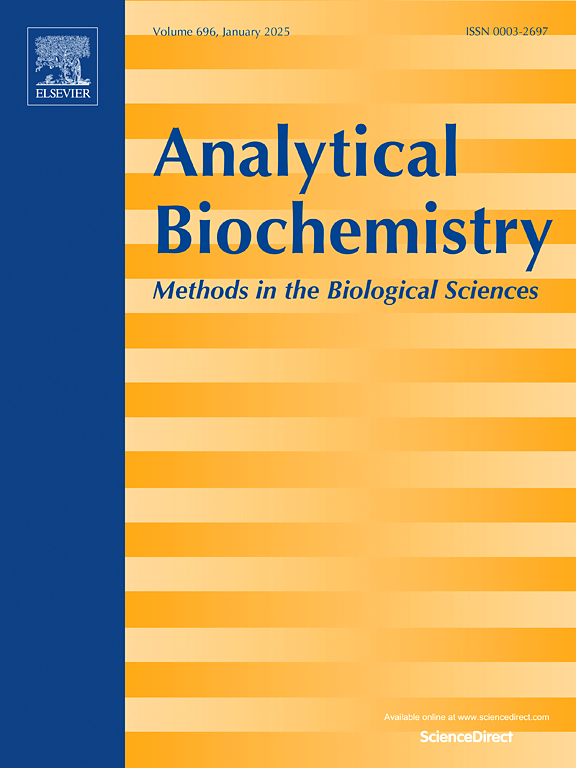Aptasensor based on rGO-AuNPs Field-effect Transistor for selective detection of Escherichia coli in river water
IF 2.5
4区 生物学
Q2 BIOCHEMICAL RESEARCH METHODS
引用次数: 0
Abstract
Water and food-borne diseases are public health problems. It is estimated that only water-borne diseases cause 2.2 million deaths annually. E. coli is one of the most important bacteria in water monitoring and is on the WHO's list of priority pathogens for diagnosis and treatment. Conventional methods for detecting E. coli are not effective due to their time-consuming nature, the need for expensive equipment, and low sensitivity. Therefore, a rapid diagnostic method is essential for accurate detection of E. coli. Here, a Field-effect Transistor (FET) was used to detect E. coli based on rGO, AuNPs, and ssDNA-aptamer. After characterizing the rGO-AuNPs-Apt FET, the current of the nanobiosensor was measured with each modification. The nanobiosensor's linear range was (3–3 × 106 CFU/ml), and LOD reached 3 CFU/ml in the PBS buffer. The nanobiosensor's response was completely selective and stable for up to 4 weeks. The rGO-AuNPs-Apt FET specifically detected E. coli in the river water down to 10 CFU/ml, even in a mixture of other bacteria at higher concentrations. The small sample size, ease of use, and accuracy of detection are the advantages of rGO-AuNPs-Apt FET, which can be used as a sensor for water monitoring in 15 min.

基于rGO-AuNPs场效应晶体管的感应传感器选择性检测河水中大肠杆菌
水和食源性疾病是公共卫生问题。据估计,每年仅水媒疾病就造成220万人死亡。大肠杆菌是水监测中最重要的细菌之一,被列入世卫组织诊断和治疗的重点病原体清单。传统的检测大肠杆菌的方法由于其耗时,需要昂贵的设备和低灵敏度而无效。因此,一种快速的诊断方法对于准确检测大肠杆菌至关重要。本研究利用场效应晶体管(FET)检测基于还原氧化石墨烯、AuNPs和ssdna适配体的大肠杆菌。在对rGO-AuNPs-Apt FET进行表征后,测量了每次修饰后纳米生物传感器的电流。纳米传感器的线性范围为(3 - 3 × 106 CFU/ml),在PBS缓冲液中LOD可达3 CFU/ml。纳米生物传感器的反应在长达4周的时间内是完全选择性和稳定的。rGO-AuNPs-Apt FET在低至10 CFU/ml的河水中特异性检测到大肠杆菌,即使在其他细菌浓度较高的混合物中也是如此。rGO-AuNPs-Apt FET的优点是样本量小,易于使用,检测准确,可在15分钟内用作水监测传感器。
本文章由计算机程序翻译,如有差异,请以英文原文为准。
求助全文
约1分钟内获得全文
求助全文
来源期刊

Analytical biochemistry
生物-分析化学
CiteScore
5.70
自引率
0.00%
发文量
283
审稿时长
44 days
期刊介绍:
The journal''s title Analytical Biochemistry: Methods in the Biological Sciences declares its broad scope: methods for the basic biological sciences that include biochemistry, molecular genetics, cell biology, proteomics, immunology, bioinformatics and wherever the frontiers of research take the field.
The emphasis is on methods from the strictly analytical to the more preparative that would include novel approaches to protein purification as well as improvements in cell and organ culture. The actual techniques are equally inclusive ranging from aptamers to zymology.
The journal has been particularly active in:
-Analytical techniques for biological molecules-
Aptamer selection and utilization-
Biosensors-
Chromatography-
Cloning, sequencing and mutagenesis-
Electrochemical methods-
Electrophoresis-
Enzyme characterization methods-
Immunological approaches-
Mass spectrometry of proteins and nucleic acids-
Metabolomics-
Nano level techniques-
Optical spectroscopy in all its forms.
The journal is reluctant to include most drug and strictly clinical studies as there are more suitable publication platforms for these types of papers.
 求助内容:
求助内容: 应助结果提醒方式:
应助结果提醒方式:


